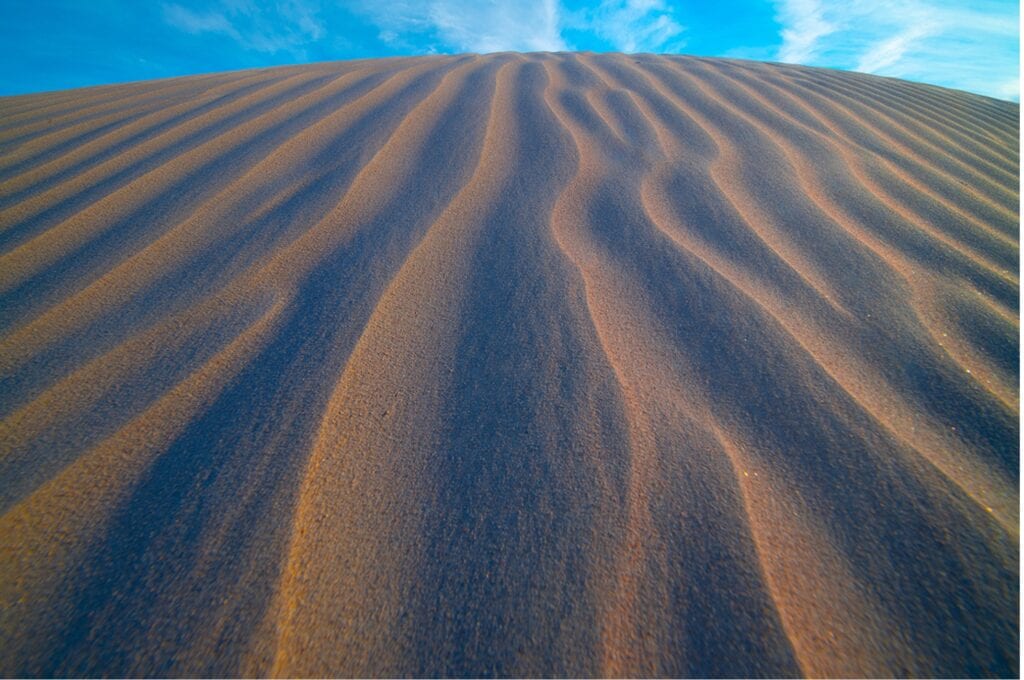Tips and Tricks for Sand Dune Photography
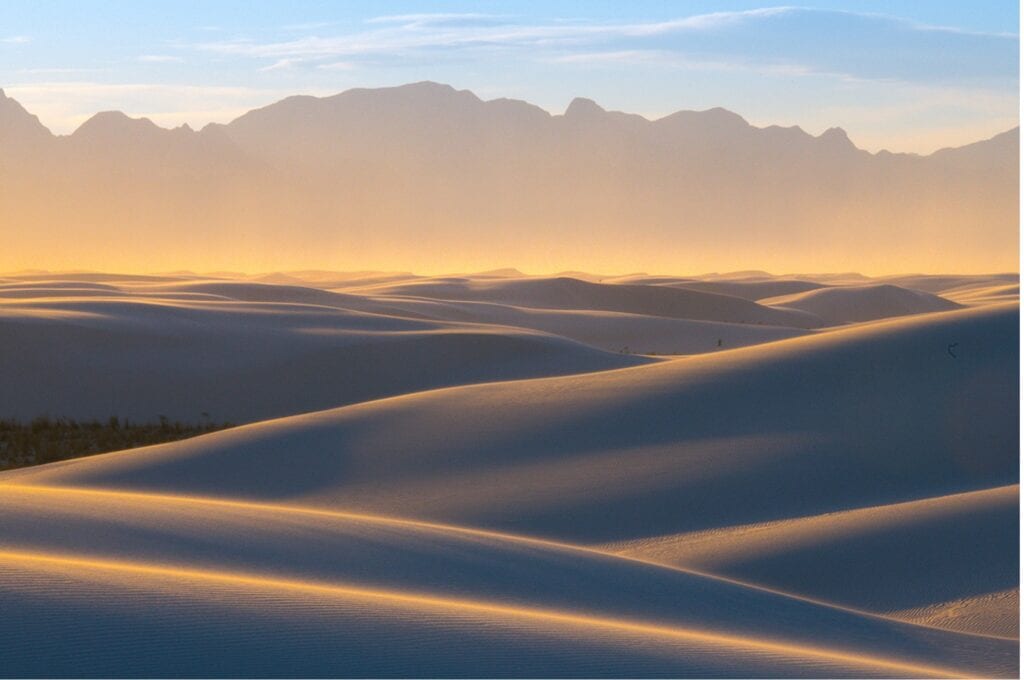
The variety and uniqueness of sand dunes make them one of my favorite landscape subjects to photograph. Several vital elements help images of dunes to resonate with viewers: light, color harmony, and composition. Each of these concepts individually increases the chances of success, but combining all three elements is the best way to create impactful dune images.
Join Us in Death Valley Nov/Dec 2022!
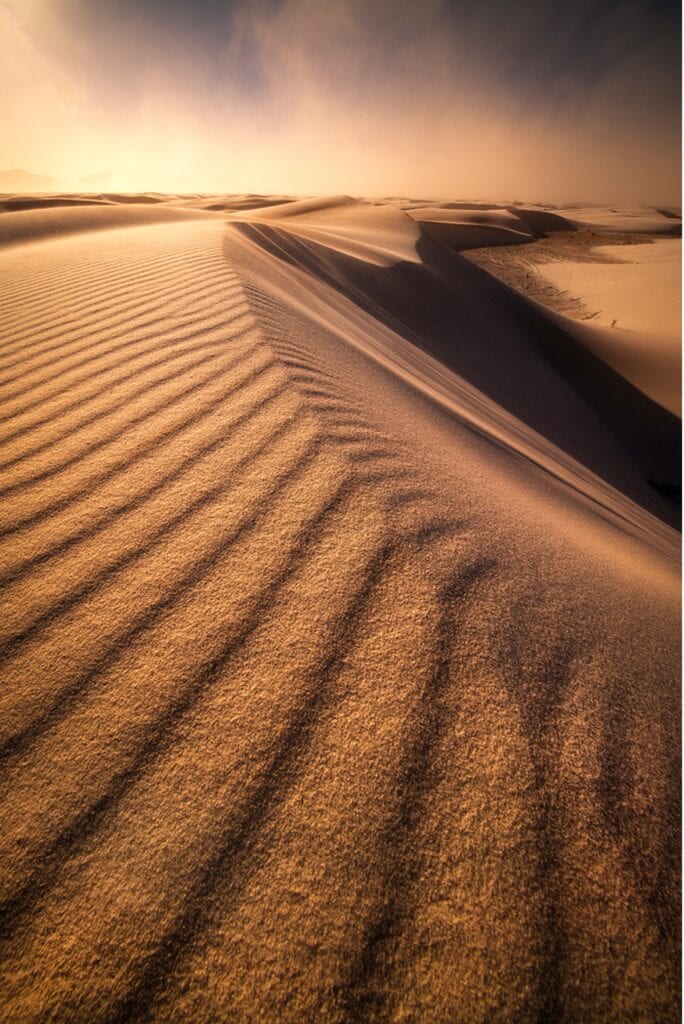
In this article, I discuss essential notions for improving your dune photography. Capturing what makes a dune unique and conveying that in your image will demonstrate to your viewer why you are drawn to a particular scene. Pre-visualization is a fundamental step that I consistently practice when preparing to photograph. I research the Internet to find images that capture a certain mood, and I think about why that image has drawn me in. The characteristics of light, color harmony, and composition are three concepts that stand out consistently. My objective is not to copy those photos but to capture the same striking mood and color that made those images memorable. Identify the ideas that are important to you as these concepts are unique to each photographer.

Knowing when to photograph is one of the essential factors in capturing great images. Light makes or break an image, and can transform an ordinary photo into an incredible image. Shortly before and after sunrise or late in the evening are the best times to photograph dunes. In photography, we refer to these times as the ‘magic hours,’ when the sun is close to the horizon, and the light highlights the landscape. The colors are accentuated based on the sun’s position. As the sun descends and gets closer to the horizon, the light becomes warmer, and the shadows longer. The dunes reflect in warm tones, and the textures in the sand come alive. It’s amazing to watch the dunes turn from a warm color palette to an almost immediate cool-tone. The reflective nature of the sand enhances the magenta and pink hues of the twilight sky, and soft twilight colors showcase the unique patterns and flow of the dunes. The combination of reflected color on the dunes and the designs in the sand become a thing of beauty. Timing and the type of light are critical when looking to create images that stand out with impact. Not only is good light a prerequisite, but it is essential to consider how the properties interact with each other.

Color Harmony refers to two colors that face directly across from each other on the color wheel, and this concept is often overlooked in landscape photography. Understanding color theory is essential to becoming a better photographer. Color stimulates the senses and makes an image unforgettable. Each color in an image has a relationship to the other, and the arrangement of these colors dictates how the image is perceived.

When framing dunes, I look for a balance of complementary colors that evoke a certain mood. Timing your shots around sunrise or sunset will ensure you have warm and cool tones throughout the image, creating visual tension. The strategic placement of opposing tonalities creates contrast, and the interaction between the color tones creates depth and dimension. It’s essential to consider color harmony in images. Images photographed during the twilight hour have primarily cool tones of pastel pink and purple. Twilight photography conveys a mood that is much more subdued. Incorporating hints of warmth helps to balance the overall color mood. Understanding creative color theory and how color properties relate to one another are important in creating stand-out images.
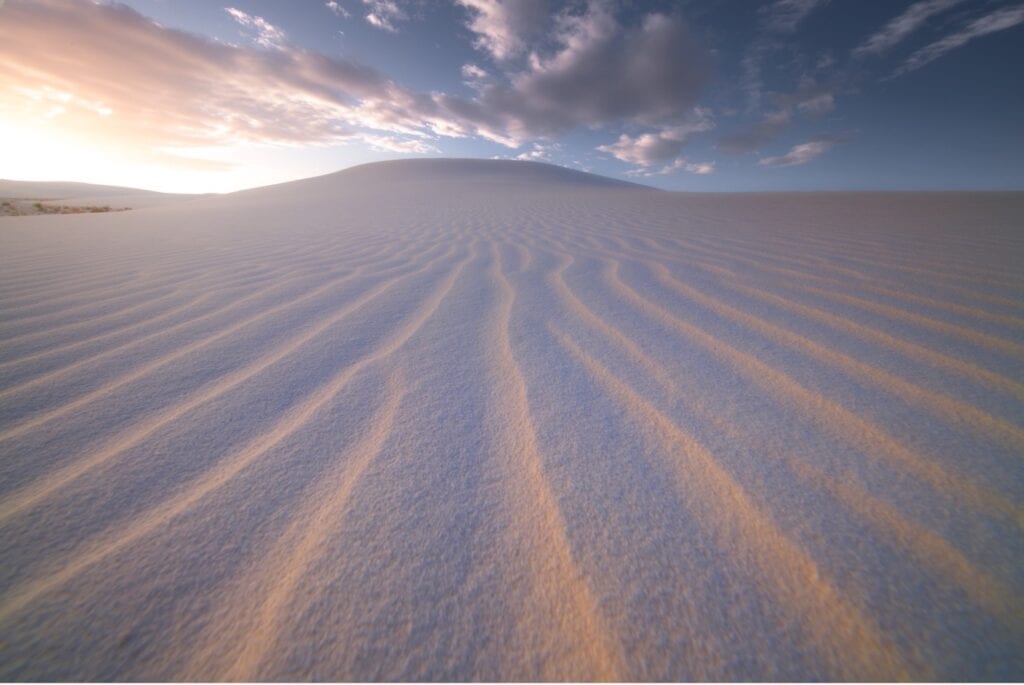
Photographing between the magic hours of sunrise and sunset allows me to take advantage of warmer tones, while complementing the ripples with cooler shadows. The peaks receive the warm sunlight, while the backside receives the shadows. It is essential to balance the color weight.

Composition brings the creative elements of your image together in a compelling fashion. It is defined as the way lines, shapes, and colors are arranged in an image. A good composition creates compelling arrangements that connects with the viewer. Anything that detracts from the image needs to be eliminated from the overall scene. The goal is to avoid chaos, less is more.
It is always best to have preconceived ideas in mind before you head out to shoot. Organizing the details ahead of time allows you to break the subject down into the simplest of terms. When it comes to composition, simplicity and order tell a story to the viewer and leaves a lasting impression. The human mind craves structure and order, and when elements are connected, it gives the image purpose and direction. Creativity is so important when arranging the details – visualize the items in a way that articulates your story.
A few essential concepts should dictate how you place a composition. Balance and weight need to be correct in order to make the main subject clear and dominant. Additional components should support the central element of the story. Look for elements in the foreground that stand out. Divide your image into a series of grids and place the points of interest where the alliance commands attention and directs the eye away from the center of the frame. When photographing dunes, I always aim to place sand ripples in the foreground. They provide strong leading lines and guide the viewer’s eye to the main subject. Generally, it is best to get lower and close to accentuate size and depth.
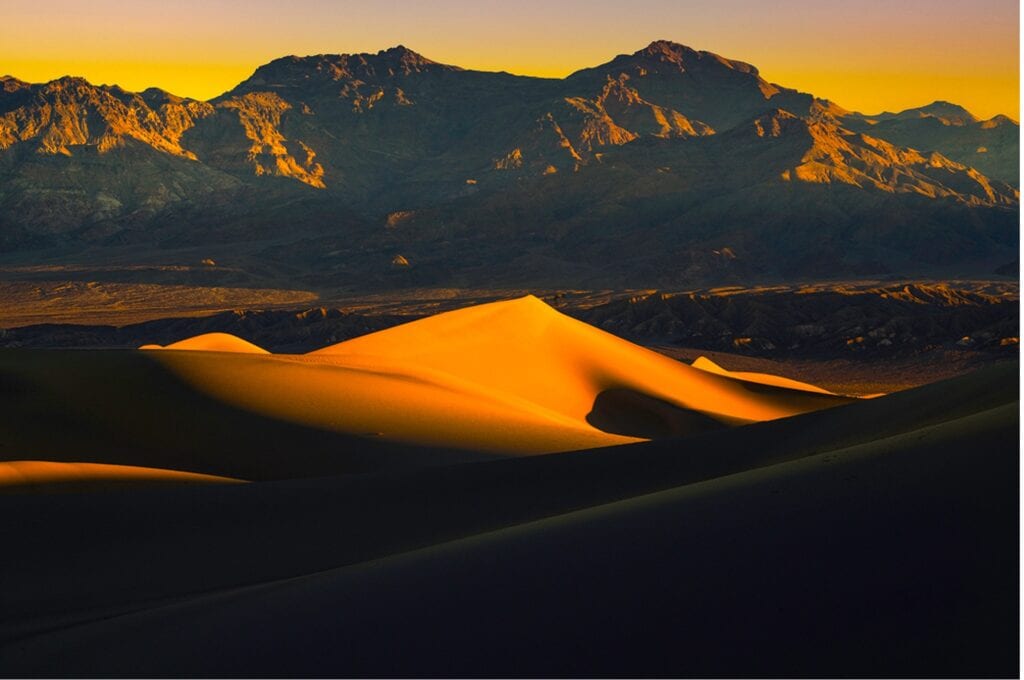
Dominance within a composition is significant. The human brain scans a scene, focuses on what it finds attractive, and subconsciously disregards the rest. Move closer or use a lens to increase the subject’s size and allow it fill the frame. Select a camera position that isolates the subject from the messy or merging background. Telephoto lenses are an excellent tool for isolating patterns in distant dunes. Try photographing an object from overhead or from below to convey isolation. To create a dominant perspective, get yourself to the highest point possible. An elevated view compresses the scene and includes only what is essential to the image. In contrast, a low angle to the dunes will enable you to include the sky and more foreground.
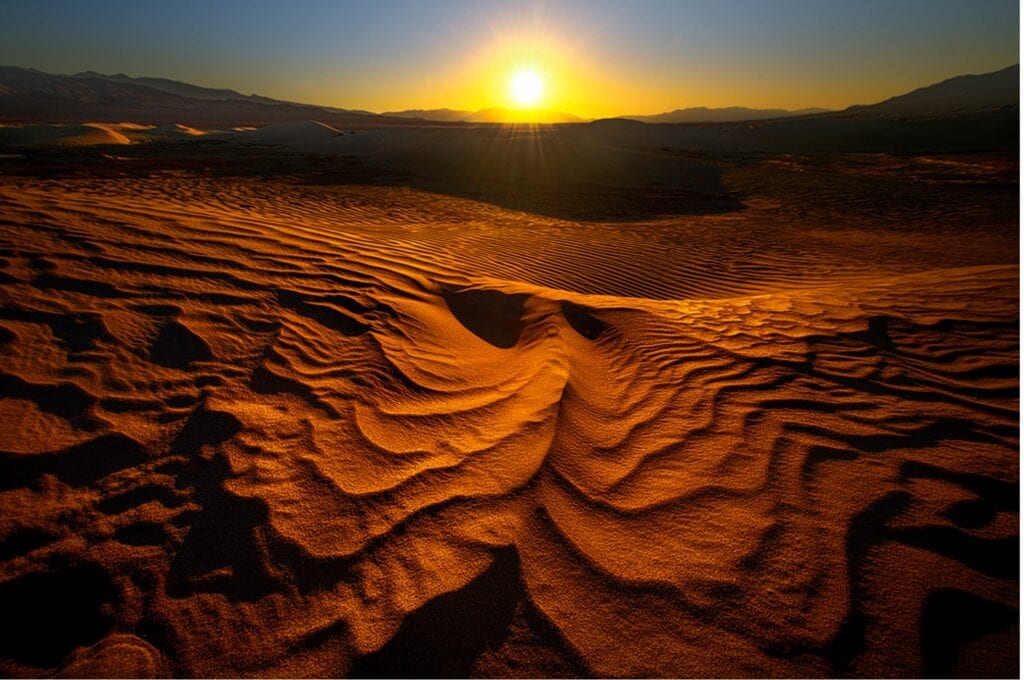
Sand ripples provide a strong leading line that guides the viewer to the top of the dunes and into the sky. Every object or element in a photograph has a particular visual weight, decided by shape, size, location, frame and color. Create balance by being mindful of what to include and not include in an image. For example, you might want to convey the feeling of wide open space by using a wide angle lens.
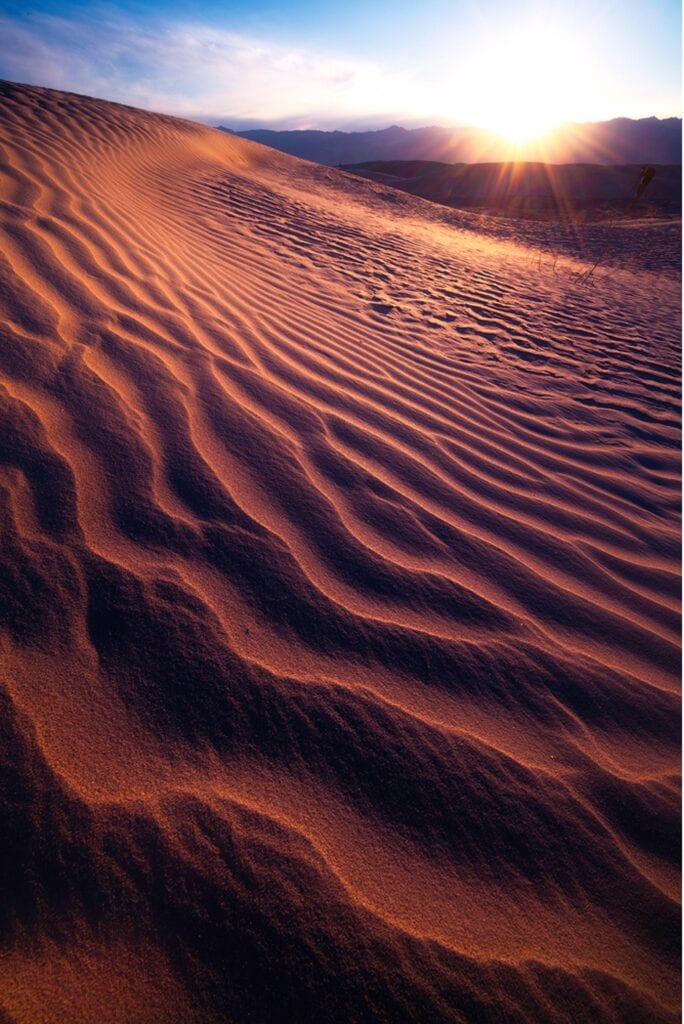
A dynamic foreground sets the tone for the rest of the image. Wide angle lenses exaggerate objects nearby and make them appear larger. Consider depth and dimensionality to create layers within the image, and be sure to connect elements within the image. Frame the scene to include multiple layers and repeating patterns that recede into the background. An example of this is similarly shaped dunes or sand ripples that converge in the distance.
Design template is the theory that pictures project an idea, relationship, or concept by bringing different elements together, creating a combination of visual themes and an optical center of interest. Visually arranging the composition in terms of patterns tells a story in an organized manner that makes sense. Although visual templates could be an article in their own right, there are a few that work well with dunes.
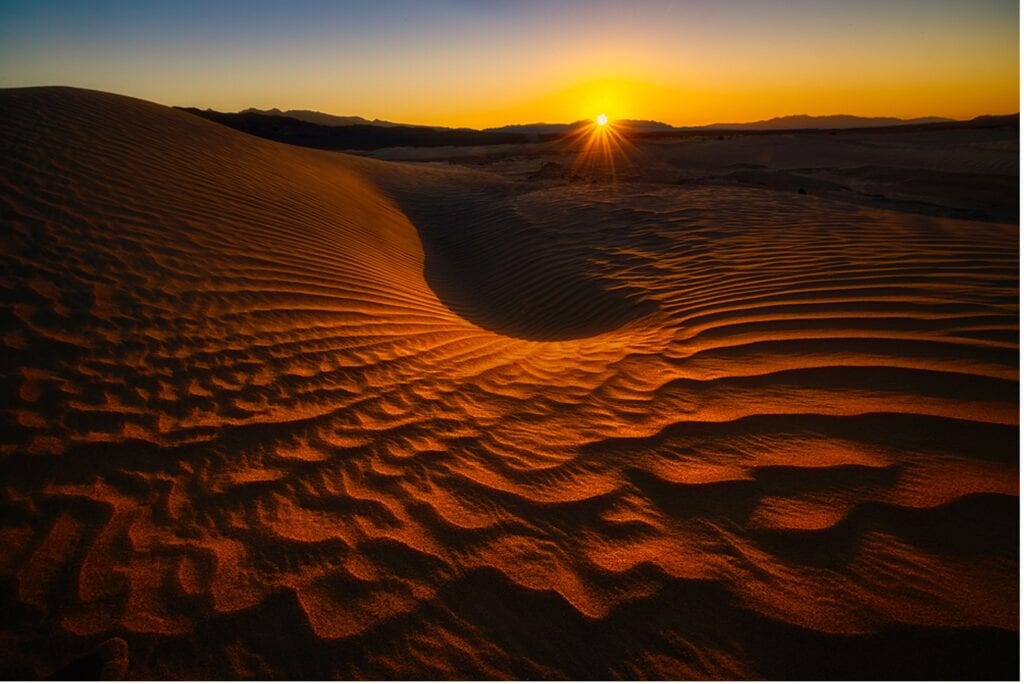
The S-Curve pattern is one of the most common design patterns found in dunes. Using the contrast of light and shadow, S-curves can effectively connect all the elements in an image. The next design pattern that stands out in terms of composition is the juxtaposition of near and far elements. Intentional framing of a foreground subject which is in direct contrast to a similar scene in the background creates tension and depth in an image. Receding elements are another example of using visual design for depth. Framing similar elements in an image that become increasingly smaller in the distance gives the viewer a sense of depth.
When it comes to creativity, it is essential to think outside the box. It’s easy to get tunnel vision and become pre-occupied with one style and idea. Think in terms of creating different perspectives the evoke a mood. Try things that bring you out of your comfort zone, and don’t forget to frame both vertically and horizontally. Don’t forget to think small and look for the finer details. The only rules for photographing dunes, is be creative and remember to tell a story that resonates with the viewer.
